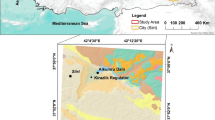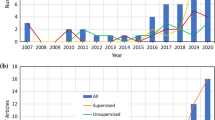Abstract
El Salvador and Central America in general are highly prone to landsliding. In November 1998, Hurricane Mitch killed 240 people, displaced about 85,000 people, caused more than $600 million in economic losses, and damaged about 60 % of the nation’s roads (Rose et al. in Natural hazards in El Salvador. Geologic Society of America of special paper 375, Boulder, 2004). An understanding of susceptibility of locations to landsliding is critical for development and mitigation planning. This work presents the development of the Normalized Landslide Index Method which is a derivative of the bivariate statistical methods commonly used in landslide susceptibility assessment. The resultant map was amended through a tangential analysis, also commonly used in landslide susceptibility mapping, the Analytical Hierarchy Process (AHP), which reduces multi-criteria analysis to pair-wise comparisons. The assimilation of results from the AHP analysis into the statistically derived susceptibility map skewed the original results by emphasizing the extremes already found. It was determined that addition of AHP results did not increase the value of the derived susceptibility map. Finally, a physically based a priori approach to landslide susceptibility mapping, developed by El Salvador National Service of Territorial Studies, was compared to the statistically derived map developed herein. It was found that the a priori approach was not sufficiently discriminant to be useful for planners and regulators, as very large areas were designated high susceptibility that included areas with low slope angles. The development of the normalized landslide index is a significant improvement to the class of bivariate statistical strategies to assess regional landslide susceptibility.













Similar content being viewed by others
References
Aguilar M, Pacheco T, Tobar J, Quiñónez J (2009) Vulnerability and adaptation to climate change of rural inhabitants in the central coastal plain of El Salvador. Clim Res 40(2–3):187–198
Akgun A (2012) A comparison of landslide susceptibility maps produced by logistic regression, multi-criteria decision, and likelihood ratio methods: a case study at Izmir, Turkey. Landslides 9:93–106
Ayalew L, Yamagishi H (2005) The application of GIS-based logistic regression for landslide susceptibility mapping in the Kakuda-Yahiko Mountains, Central Japan. Geomorphology 65:15–31
Ayalew L, Yamagishi H, Marui H, Kanno T (2005) Landslides in Sado Island of Japan: part II. GIS-based susceptibilitymapping with comparisons of results from two methods and verifications. Eng Geol 81:432–445
Baxter S (1984) Lexico Estratigrafico De El Salvador. Comision Ejecutiva Hidroelectrica Del Rio Lempa, San Salvador, El Salvador
Bell GD, Halpert MS, Ropelewski CF, Kousky VE, Douglas AV, Schnell RS, Gelman ME (1999) Climate assessment for 1998. Bull Amer Meteor Soc 80:S1–S48
Bhatt BP, Awasthi KD, Heyojoo BP, Silwal T, Kafle G (2013) Using geographic information system and analytical hierarchy process in landslide hazard zonation. Appl Ecol Environ Sci 1(2):14–22
Carrara A, Cardinali M, Guzzetti F, Reichenbach P (1995) GIS technology in mapping landslide hazard. In: Guzzetti F, Carrara A (eds) Geographical information systems in assessing natural hazards. Kluwer Academic, Dordrecht, pp 135–175
Cevik E, Topal T (2003) GIS-based landslide susceptibility mapping for a problematic segment of the natural gas pipeline, Hendek (Turkey). Environ Geol 44:949–962
Dai FC, Lee CF, Li J, Xu ZW (2001) Assessment of landslide susceptibility on the natural terrain of Lantau Island. Hong Kong Environ Geol 43(3):381–391
Dai FC, Lee CF, Ngai YY (2002) Landslide risk assessment and management: an overview. Eng Geol 64(1):65–87
Ercanoglu M, Gokceoglu C (2004) Use of fuzzy relations to produce landslide susceptibility map of a landslide prone area (West Black Sea Region, Turkey). Eng Geol 75(3/4):229–250
Frattini P, Crosta G, Carrara A (2010) Techniques for evaluating the performance of landslide susceptibility models. Eng Geol 111:62–72
GRASS Development Team (2012) Geographic resources analysis support system (GRASS) software. Open Source Geospatial Foundation Project. http://grass.osgeo.org
Hasekiogullari GD, Ercanoglu M (2012) A new approach to use AHP in landslide susceptibility mapping: a case study at Yenice (Karabuk, NW Turkey). Nat Hazards 63(2):1157–1179
Hellin J, Haigh H, Marks F (1999) Rainfall characteristics of Hurricane Mitch. Nature 399:316
Kayastha P, Dhital MR, De Smedt F (2013) Application of the analytical hierarchy process (AHP) for landslide susceptibility mapping: a case study from the Tinau watershed, west Nepal. Comput Geosci 52:398–408
Komac M (2006) A landslide susceptibility model using the analytical hierarchy process method and multivariate statistics in perialpine Slovenia. Geomorphology 74(1–4):17–28
Lan HX, Zhou CH, Wang LJ, Zhang HY, Li RH (2004) Landslide hazard spatial analysis and prediction using GIS in the Xiaojiang watershed, Yunnan. China Eng Geol 76(1–2):109–128
Lee S, Min K (2001) Statistical analysis of landslide susceptibility at Yongin. Korea Environ Geol 40:1095–1113
Lee S, Choi J, Min K (2004a) Probabilistic landslide hazard mapping using GIS and remote sensing data at Boun. Korea Int J Remote Sens 25(11):2037–2052
Lee S, Ryu J, Won J, Park H (2004b) Determination and application of the weight for landslide susceptibility mapping using an artificial neural network. Eng Geol 71:289–302
Long NT, De Smedt F (2012) Application of an analytical hierarchical process approach for landslide susceptibility mapping in A Luoi district, Thua Thien Hue Province. Vietnam Environ Earth Sci 66(7):1739–1752
Marjanovic M (2013) Comparing the performance of different landslide susceptibility models in ROC space. In: Margottini C, Canuti P, Sassa K (eds) Landslide science and practice volume 1: landslide inventory and susceptibility and hazard zoning. Springer, Berlin, p 607
MATLAB and Statistics Toolbox Release (2012).The MathWorks Inc, Massachusetts
Meisina C, Zizioli D, Zucca F (2013) Methods for shallow landslides susceptibility mapping: an example in Oltrepo Pavese. In: Margottini C, Canuti P, Sassa K (eds) Landslide science and practice volume 1: landslide inventory and susceptibility and hazard zoning. Springer, Berlin, p 607
Microsoft (2010) Microsoft excel, redmond: microsoft (2010) computer software, Washington
Mora S, Vahrson W (1991) Determinación a Prior de la Amenaza de Deslizamientos in Grandes Áreas y Utilizando Indicadores Morfodinámicos. Universidad de Costa Rica y Universidad Nacional de Costa Rica. Julio, Instituto Costarricense de Electricidad, Costa Rica
Parise M (2001) Landslide mapping techniques and their use in the assessment of the landslide hazard. Phys Chem Earth Part C 26(9):697–703
Pasch RJ, Avila LA, Jiing J (1998) Atlantic tropical systems of 1994 and 1995: a comparison of a quiet season to a near-record breaking one. Mon Weather Rev 126:1106–1123
Perotto-Baldiviezo HL, Fisher RF, Wu XB, Thurow TL, Smith CT (2004) GIS-based spatial analysis and modeling for landslide hazard assessment in steeplands, Southern Honduras. Agric Ecosyst Environ 103(1):165–176
QGIS Development Team (2014) QGIS Geographic Information System. Open Source Geospatial Foundation Project. http://qgis.osgeo.org
Quinn PE, Hutchinson DJ, Diederichs MS, Rowe K (2010) Regional-scale landslide susceptibility mapping using weights of evidence method: an example applied to linear infrastructure. Can Geotech J 47:905–927
Rautela P, Lakhera RC (2000) Landslide risk analysis between Giri and Ton Rivers in Himalaya (India). Int J Appl Earth Obs Geoinform 2:153–160
Rose WI, Bommer JJ, Sandoval C, Carr MJ, Majors JJ (2004) Natural hazards in El Salvador. Geologic Society of America of Special Paper 375, Boulder
Saaty TL (1980) The Analytical Hierarchy Process. McGraw Hill, New York
SNET (2004) Memoria Técnica Para el Mapa de Susceptibilidad de Deslizamientos de Tierra en El Salvador. Servicio Nacional de Estudios Territoriales, Ministerio de Medio Ambiente y Recursos Naturales, El Salvador
Van Den Eeckhaut M, Vanwalleghem T, Poesen J, Govers G, Verstraeten G, Vandekerckhove L (2006) Prediction of landslide susceptibility using rare events logistic regression: a case-study in the Flemish Ardennes (Belgium). Geomorphology 76:392–410
Van Westen CJ (1997) Statistical landslide hazard analysis, ILWIS application guide 5: 73–84. ITC, Enschede
Yalcin A (2008) GIS-based landslide susceptibility mapping using analytical hierarchy process and bivariate statistics in Ardesen (Turkey): comparisons of results and confirmations. Catena 72:1–12
Yohsimatsu H, Abe S (2006) A review of landslide hazards in Japan and assessment of their susceptibility using an analytical hierarchic process (AHP) method. Landslides 3:149–158
Zeˆzere JL (2002) Landslide susceptibility assessment considering landslide typology, a case study in the area north of Lisbon (Portugal). Nat Hazard Earth Syst Sci 2:73–82
Acknowledgments
The authors are thankful to the UN World Meteorologic Organization and the US Agency for International Development for the support of this project. Additional support was provided by the Technology Transfer Program of the Hydrologic Research Center. The authors would also like to thank the staff at SNET (Mario Reyes and Manuel Diaz), El Salvador, for their cooperation in providing data, maps, references, and details about specific landslide events. This work could not have been accomplished without their help.
Author information
Authors and Affiliations
Corresponding author
Rights and permissions
About this article
Cite this article
Posner, A.J., Georgakakos, K.P. Normalized Landslide Index Method for susceptibility map development in El Salvador. Nat Hazards 79, 1825–1845 (2015). https://doi.org/10.1007/s11069-015-1930-4
Received:
Accepted:
Published:
Issue Date:
DOI: https://doi.org/10.1007/s11069-015-1930-4




